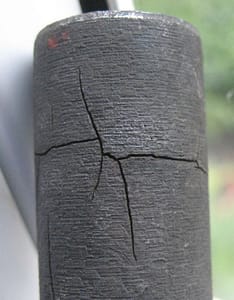NDT Test Timing of Heat Treatment Status
NDT Test Timing of Heat Treatment Status – Many standards require that the timing of NDT testing be performed after heat treatment.
Here are 4 common“Fires” for heat treatment.
Annealing:
The steel work piece is heated to 30-50 ° C above AC3 and held for a period of time to homogenize the austenite structure and refine the grains, followed by slow cooling in the furnace (or buried in sand or lime) to below 500 ° C, a heat treatment process in which air is cooled to room temperature. It can eliminate the defects of coarse structure, ferrite or carbide, composition segregation and internal stress in the workpiece during hot working.
Normaliz:
A heat treatment process in which a steel workpiece is heated to a suitable temperature above the critical point AC3 or ACCM for a certain period of time to achieve full austenization and then cooled to room temperature in air. It also eliminates coarse grain size, composition segregation, bulk or network ferrite or carbide produced during thermal processing.
Quenching:
A heat treatment process in which steel workpieces are heated to austenitizing and then cooled rapidly at an appropriate cooling rate to produce martensite transformation in the whole or some extent in the cross section of the workpieces.
Temper:
The quenched workpiece is heated to a suitable temperature below the critical point AC1 for a certain period of time, and then cooled in a way that meets the requirements to obtain the required microstructure and properties of the heat treatment process.
For carbon or low-alloy steels, the annealing, normalizing, and quenching processes generally involve heating the steel to a temperature capable of achieving full austenization and holding the steel for a period of time, in the choice of different cooling rate so as to get different microstructure.
High temperature tempering:
High temperature tempering (tempering temperature range is 500 ~ 650 ° C): after cooling, generally the product is tempered sorbite.
Moderate tempering:
Moderate tempering (tempering temperature range 350-500 ° C-RRB-: generally obtained after cooling is tempered trochoite.
Low temperature tempering:
Low temperature tempering (tempering temperature range is 150-250 ° C) is also called“Stress relief tempering”: after cooling, generally get is tempered martensite.
During the process of performance heat treatment, the internal microstructure will change obviously, which may produce heat treatment crack, for example, high-alloy steel or high-carbon steel in water quenching is prone to produce quenching cracks. The actual product may also have a variety of heat treatment processes, such as performance heat treatment after completion may be added to make the performance and size more stable stress annealing. Stress-free annealing has no effect on performance.

Therefore, in general, the NDT test should be performed after all heat treatments, whether performance heat treatment or stress annealing or aging treatment, so that we can minimize the NDT missed test. It is important to note that the NDT does not detect all defects, but only macro defects of a certain size, very small defects or microscopic defects can only be examined by other methods such as gold equivalents.
Learn more our project quality managemet, QAQC and third party inspection (TPI), NDT practices thru below link.-
https://www.jsc-safe.com/hydrostatic-test-hydro-test/
